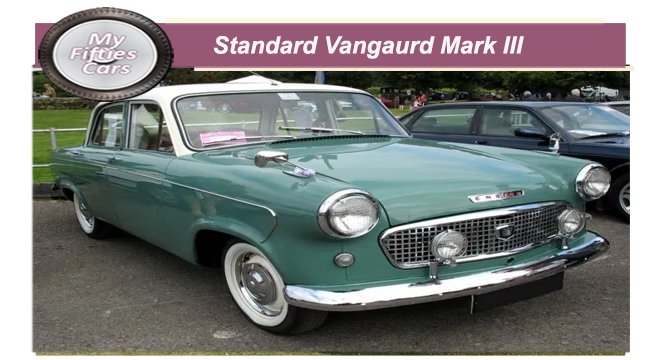
In October 1955, the familiar Standard Vanguard, which, even in its Phase II configuration was beginning to look rather dated, gave way to the Phase III model in which the principal change was a completely new integrally constructed bodyshell.
S ubstantial chassis type members were welded into the structure at both front and rear, each terminating where they met with similar transverse stiffeners under the floor. The transverse sections were tied into the sill structure, and the bottom end rigidity of the structure as a whole was such as to suggest that perhaps a convertible model would follow, although in the event this was not to be the case.
ubstantial chassis type members were welded into the structure at both front and rear, each terminating where they met with similar transverse stiffeners under the floor. The transverse sections were tied into the sill structure, and the bottom end rigidity of the structure as a whole was such as to suggest that perhaps a convertible model would follow, although in the event this was not to be the case.
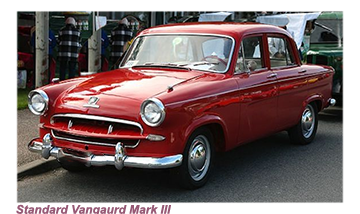 The considerable glass area included a full-width rear window which left only narrow rear quarter pillars, and a notable feature of the four front-hinged doors was that their steel construction terminated at window sill level.
The considerable glass area included a full-width rear window which left only narrow rear quarter pillars, and a notable feature of the four front-hinged doors was that their steel construction terminated at window sill level.
Bright metal embellishment was confined to the simple grille surround, headlamp and rear lamp rims, boot lid hinges, door handles, bumpers — complete with over-riders, hubcaps and screen surrounds, and the car's appearance as a whole was clean and uncluttered.
An increase in the wheelbase of 8 inches over the previous model provided a much-improved layout in so far as the rear seat passengers were concerned. Both the full-width bench seats were upholstered in vynide, and both featured pull-down centre armrests. 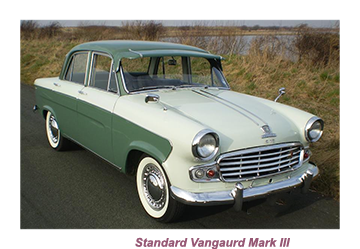 All four doors were equipped with armrest/door pulls, and each also featured window winding mechanism and swivelling quarter windows.
All four doors were equipped with armrest/door pulls, and each also featured window winding mechanism and swivelling quarter windows.
Facing the driver was a two-spoke steering wheel with a half horn ring and a neat and comprehensive instrument panel.
G auges for fuel level, oil pressure, water temperature, and an ammeter were in a row beneath an arc-shaped speedometer. Pendant foot pedals for the clutch and brakes were an up-to-date feature, as were flashing indicators. A heating and the de-misting unit, and electric screen washers were standard equipment.
auges for fuel level, oil pressure, water temperature, and an ammeter were in a row beneath an arc-shaped speedometer. Pendant foot pedals for the clutch and brakes were an up-to-date feature, as were flashing indicators. A heating and the de-misting unit, and electric screen washers were standard equipment.
With a maximum speed of almost exactly 80mph and the ability to reach 70mph from rest in around 37/38 seconds the Phase III model had a similar performance to that of the previous model,
![]()
However, the higher overall gearing and lighter weight resulted in this being accompanied by a worthwhile improvement in fuel economy with total journey figures in the 27/28mpg range being easily attainable.
The general ride and handling qualities also showed an improvement, the lower centre of gravity resulting in slightly less lean during fast cornering despite the absence now of anti-roll bars.
F rom its launch, the Phase III Vanguard had to face some stiff opposition, principally from the Austin Westminster De-Luxe, the Ford Zodiac and the Vauxhall Cresta.
rom its launch, the Phase III Vanguard had to face some stiff opposition, principally from the Austin Westminster De-Luxe, the Ford Zodiac and the Vauxhall Cresta.
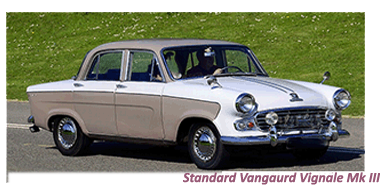 All three of these cars were offering rather more speed and acceleration in addition to the superior mechanical refinement usually associated with in-line 6-cylinder engines, while the Cresta, and particularly the Zodiac, were also more comprehensively equipped.
All three of these cars were offering rather more speed and acceleration in addition to the superior mechanical refinement usually associated with in-line 6-cylinder engines, while the Cresta, and particularly the Zodiac, were also more comprehensively equipped.
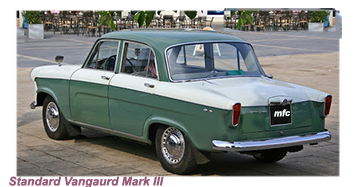 However, the Vanguard was to prove to be a worthy contender, holding its own very well in this price category, and certainly more than just continuing to please those who had been well served by the previous models.
However, the Vanguard was to prove to be a worthy contender, holding its own very well in this price category, and certainly more than just continuing to please those who had been well served by the previous models.
The range multiplied in August 1956 with the announcement of the Vanguard Sportsman. As its name suggested, the Sportsman was a high-performance edition of the Vanguard, offering a useful increase in both speed and acceleration.
 Although of the same capacity, the Sportsman's engine differed in several important respects from that in the basic model and incorporated features of the 1991 cc derivative of this unit which powered the company's Triumph TR3 sports car.
Although of the same capacity, the Sportsman's engine differed in several important respects from that in the basic model and incorporated features of the 1991 cc derivative of this unit which powered the company's Triumph TR3 sports car.
Identifying the Sportsman externally was a new grille of rather more traditional radiator-shape, deeper bumpers and over-riders, and a two-tone paint finish.
The interior boasted two-tone hide, or a hide and cloth combination for the upholstery, a cigar lighter, and an electric clock.
![]()
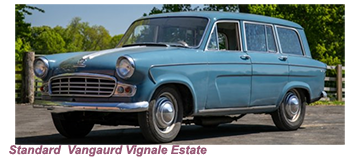 Completing the Vangaurd range was the Phase III Estate.
Completing the Vangaurd range was the Phase III Estate.
Based closely on the saloon, the estate car bodywork retained the rear passenger doors, rear wings and taillight treatment. Access to the new loading area was through a horizontally split tailgate, the upper half of which featured a large window and was arranged to lift upwards.
The range diversified further one year later, when, in October 1957, the Ensign saloon was announced. Essentially a de-trimmed Vanguard, the Ensign was identified by a simple mesh grille, painted headlamp surrounds and lack of over-riders.p> p> I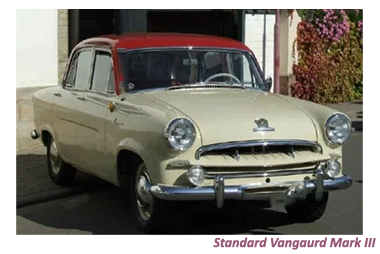 nside, the bench seats and doors were without armrests, and the only instrument in addition to the speedometer was the fuel gauge.
nside, the bench seats and doors were without armrests, and the only instrument in addition to the speedometer was the fuel gauge.
From October 1958, the Vanguard became "Vignale Vanguard" (the styling changes had been inspired by Michelotti, who had links with the Italian concern).
 Within the same basic monocoque, Vignales had larger front and rear windows, new grille and tail lamps, two-tone colour schemes and upgrades inside the cabin.
Within the same basic monocoque, Vignales had larger front and rear windows, new grille and tail lamps, two-tone colour schemes and upgrades inside the cabin.
The Vignale carried on after the announcement of the Vanguard Six in late 1960, now with the four-speed floor-change transmission as standard. The last car was produced in August 1961.


